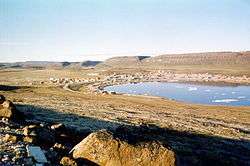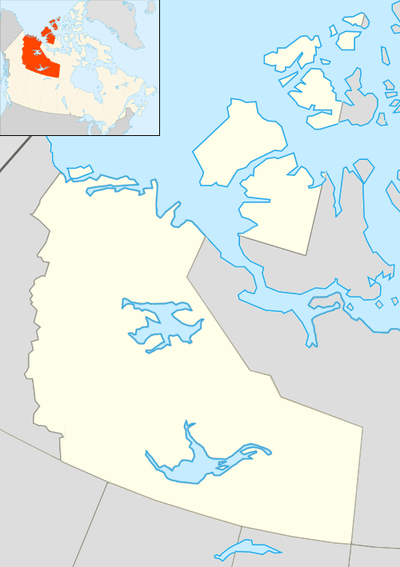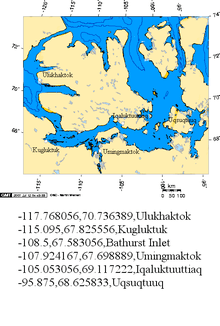Ulukhaktok
| Ulukhaktok Ulukhaqtuuq Uluqsaqtuuq formerly Holman | |
|---|---|
| Hamlet | |
 Looking at Ulukhaktok from the bluffs that give the community its name. | |
 Ulukhaktok  Ulukhaktok | |
| Coordinates: 70°44′11″N 117°46′05″W / 70.73639°N 117.76806°WCoordinates: 70°44′11″N 117°46′05″W / 70.73639°N 117.76806°W | |
| Country | Canada |
| Territory | Northwest Territories |
| Region | Inuvik Region |
| Constituency | Nunakput |
| Census division | Region 1 |
| Settled | 1937 |
| Incorporated (hamlet) | 1 April 1984[1] |
| Government | |
| • Mayor | Laverna Klengenberg |
| • Acting Senior Administrative Officer | Susan Kaodloak |
| • MLA | Jackie Jacobson |
| Area[2] | |
| • Land | 124.45 km2 (48.05 sq mi) |
| Elevation | 36 m (118 ft) |
| Highest elevation | 36 m (118 ft) |
| Lowest elevation | 0 m (0 ft) |
| Population (2016)[2] | |
| • Total | 396 |
| • Density | 3.2/km2 (8/sq mi) |
| Time zone | UTC−7 (MST) |
| • Summer (DST) | UTC−6 (MDT) |
| Canadian Postal code | X0E 0S0 |
| Area code(s) | 867 |
| Telephone exchange | 396 |
| - Living cost | 177.5A |
| - Food price index | 186.4B |
|
Sources: Department of Municipal and Community Affairs,[3] Prince of Wales Northern Heritage Centre,[4] Canada Flight Supplement[5] ^A 2013 figure based on Edmonton = 100[6] ^B 2015 figure based on Yellowknife = 100[6] | |
Ulukhaktok (Kangiryuarmiutun (Inuit language) spelling Ulukhaqtuuq [ulukhɑqtuːq̚] and known until 1 April 2006 as Holman or Holman Island) is a small hamlet on the west coast of Victoria Island, in the Inuvik Region of the Northwest Territories, Canada.
Like other small traditional communities in the territories, hunting, trapping, and fishing are major sources of income, but printmaking has taken over as the primary source of income in recent years.
The two principal languages in Ulukhaktok are the Kangiryuarmiutun dialect of Inuinnaqtun, which is politically part of the Inuvialuktun group, and English.
History

The first people to settle in the area were Natkusiak and his family in 1937. Two years later, the Hudson's Bay Company relocated from Walker Bay and a Roman Catholic mission was opened the same year.
The English name, Holman, was in honour of J.R. Holman, a member of Sir Edward Augustus Inglefield's 1853 expedition in search for the Arctic explorer, John Franklin.[7] The community was sometimes known as Holman Island. This, however, is the name of the small island outcrop to the east-southeast in the Amundsen Gulf.
In 2006, the community was renamed, Ulukhaktok, the traditional Kangiryuarmiutun name for the area, which means "the place where ulu parts are found", or "a large bluff where we used to collect raw material to make ulus".[8][9] The large bluff that overlooks Ulukhaktok was the source that provided the slate and copper used to make ulus and give the community its name. Thus, the people who live there are called Ulukhaktokmiut ("people of"). Ulukhaktokmiut is a recent word as no people actually lived permanently in this area until the opening of the Hudson's Bay Company store, although people did visit the area to obtain the ulu materials and camp en route to other nomadic seasonal camp areas.
Inuit traded with mainland groups as far east as King William Island and as far south as Great Bear Lake although most commerce occurred with the Inuvialuit and Copper Inuit populations indigenous to the Coppermine River watershed and Bernard Harbour seasonal areas on the mainland. The majority of Ulukhaktokmiut come from a varied background, with family ties extending mainly to the Coppermine River community of Kugluktuk, Nunavut and the communities of the Mackenzie River Delta and Beaufort Sea, though some families have relatives as far away as Gjoa Haven on King William Island, and along the north slope of Alaska as far as Port Clarence on the Seward Peninsula.
Some families are descendants of the Danish explorer-trader Christian Klengenberg.[10] Others are descended from two members of the Vilhjalmur Stefansson-led, Canadian Arctic Expedition. The first was Natkusiak, a friend of Stefansson, he was the primary guide and lead hunter of the expedition. Originally from Port Clarence, Alaska he was later known as Billy Banksland, this name came from his time trapping Arctic foxes on Banks Island.[11] Another member of the expedition with relatives in the area was the Alaskan Iñupiat, Ikey Bolt from Point Hope. Married to Klengenberg's daughter Etna, they lived for several years at Rymer Point before moving to Minto Inlet and eventually to Coppermine (now Kugluktuk).[12]
Demographics
The 2016 Census indicated a population of 396, a decrease of 1.5% from the 2011 Census and of these 370 (96,4%) were Inuvialuit or Inuit and the rest (6.6%) were non-Indigenous. The main languages in the community are Inuinnaqtun (Inuvialuktun) and English[2]
| Historical population | |||||||||||||||||||||||||||||||||||||||||||||||||||||||||||||||||||||||||
|---|---|---|---|---|---|---|---|---|---|---|---|---|---|---|---|---|---|---|---|---|---|---|---|---|---|---|---|---|---|---|---|---|---|---|---|---|---|---|---|---|---|---|---|---|---|---|---|---|---|---|---|---|---|---|---|---|---|---|---|---|---|---|---|---|---|---|---|---|---|---|---|---|---|
|
| ||||||||||||||||||||||||||||||||||||||||||||||||||||||||||||||||||||||||
| Sources: NWT Bureau of Statistics (2001 - 2017)[13] | |||||||||||||||||||||||||||||||||||||||||||||||||||||||||||||||||||||||||
In 2017 the Government of the Northwest Territories reported that the population was 420 with an average yearly growth rate of -0.1 from 2007.[6]
Economy
Thie hamlet has seen both sides of the rush for mineral exploration and has regained an appreciation for its wild places and culturally sensitive areas where long-gone relatives once survived and lived with the ice and snow. Some private concerns have witnessed the zeal with which these locals defend their competing interests for the same tracts of land and resources. Other companies have learned to work with residents and this has produced some hope for mineral development around traditional lands and other cultural areas of these Inuvialuit and their fellow Inuit brethren. Arts and crafts are also another source of income with international recognition of local artisans. Occasionally some residents travel to such places as San Francisco, California or Melbourne, Australia, but more often to other regional centres across the north.
Ulukhaktok is home to the Holman Eskimo Co-op which was formed by the residents of the community with the help of a Roman Catholic priest, Father Henri Tardy. The Co-op was formed to provide income to the residents of the community by producing arts and crafts, and is famous for the production of prints. Formally Holman Prints, artists in the community sell their art though the Ulukhaktok Arts Centre. Famous artists who have produced prints for the Holman Eskimo Co-op include Mary K. Okheena and Helen Kalvak. The local school, Helen Kalvak Elihakvik is named after her. The Holman Eskimo Co-op now is involved in arts and crafts, retailing, the hotel business, cable television, operates a Canada Post outlet, operates the fuel delivery contract, and is the local Aklak Air agent.
Ulukhaktok is also the location of the world's most northern golf course and hosts the "Billy Joss Open Celebrity Golf Tournament" every summer. Over the years they have managed to attract players from the Edmonton Oilers and the Edmonton Eskimos, as well as golfers from other countries. This tournament is growing and features excursions to traditional areas where Arctic char and Northern Lake trout are harvested for subsistence as well as limited commercial fishing and hunting.
Climate
Ulukhaktok has a tundra climate.
| Climate data for Ulukhaktok/Holman Airport | |||||||||||||
|---|---|---|---|---|---|---|---|---|---|---|---|---|---|
| Month | Jan | Feb | Mar | Apr | May | Jun | Jul | Aug | Sep | Oct | Nov | Dec | Year |
| Record high humidex | −7.2 | −9.4 | −7.6 | 6.9 | 10.6 | 23.0 | 27.9 | 24.5 | 17.1 | 5.1 | 0.1 | −3.2 | 27.9 |
| Record high °C (°F) | −4.0 (24.8) |
−6.5 (20.3) |
−5.0 (23) |
4.5 (40.1) |
11.5 (52.7) |
22.5 (72.5) |
29.0 (84.2) |
23.5 (74.3) |
15.8 (60.4) |
5.9 (42.6) |
1.1 (34) |
−3.0 (26.6) |
29.0 (84.2) |
| Average high °C (°F) | −24.3 (−11.7) |
−24.9 (−12.8) |
−21.4 (−6.5) |
−12.6 (9.3) |
−3.2 (26.2) |
7.8 (46) |
12.8 (55) |
9.3 (48.7) |
3.1 (37.6) |
−6.2 (20.8) |
−16.5 (2.3) |
−21.6 (−6.9) |
−8.1 (17.4) |
| Daily mean °C (°F) | −28.0 (−18.4) |
−28.8 (−19.8) |
−25.6 (−14.1) |
−17.0 (1.4) |
−6.6 (20.1) |
4.6 (40.3) |
9.0 (48.2) |
6.4 (43.5) |
0.9 (33.6) |
−8.9 (16) |
−19.8 (−3.6) |
−25.2 (−13.4) |
−11.6 (11.1) |
| Average low °C (°F) | −31.8 (−25.2) |
−32.6 (−26.7) |
−29.8 (−21.6) |
−21.4 (−6.5) |
−10.0 (14) |
1.4 (34.5) |
5.2 (41.4) |
3.4 (38.1) |
−1.3 (29.7) |
−11.4 (11.5) |
−23.1 (−9.6) |
−28.6 (−19.5) |
−15.0 (5) |
| Record low °C (°F) | −47.5 (−53.5) |
−49.0 (−56.2) |
−45.0 (−49) |
−42.1 (−43.8) |
−26.5 (−15.7) |
−12.5 (9.5) |
−3.5 (25.7) |
−5.5 (22.1) |
−15.5 (4.1) |
−36.8 (−34.2) |
−37.5 (−35.5) |
−42.8 (−45) |
−49.0 (−56.2) |
| Record low wind chill | −59.8 | −59.2 | −61.9 | −45.6 | −31.0 | −18.3 | −6.8 | −11.1 | −21.9 | −44.7 | −51.3 | −51.2 | −61.9 |
| Average precipitation mm (inches) | 8.4 (0.331) |
7.5 (0.295) |
7.3 (0.287) |
5.3 (0.209) |
7.4 (0.291) |
8.0 (0.315) |
22.4 (0.882) |
32.2 (1.268) |
19.8 (0.78) |
17.1 (0.673) |
11.5 (0.453) |
8.5 (0.335) |
155.3 (6.114) |
| Average rainfall mm (inches) | 0.0 (0) |
0.0 (0) |
0.0 (0) |
0.0 (0) |
1.1 (0.043) |
6.9 (0.272) |
22.2 (0.874) |
30.2 (1.189) |
13.2 (0.52) |
0.6 (0.024) |
0.0 (0) |
0.0 (0) |
74.2 (2.921) |
| Average snowfall cm (inches) | 8.5 (3.35) |
7.5 (2.95) |
7.5 (2.95) |
5.3 (2.09) |
6.4 (2.52) |
1.2 (0.47) |
0.2 (0.08) |
2.0 (0.79) |
6.6 (2.6) |
16.9 (6.65) |
12.3 (4.84) |
8.9 (3.5) |
83.3 (32.8) |
| Average precipitation days (≥ 0.2 mm) | 5.3 | 5.2 | 4.9 | 3.9 | 4.8 | 4.7 | 7.8 | 11.0 | 9.3 | 9.5 | 7.3 | 5.3 | 78.9 |
| Average rainy days (≥ 0.2 mm) | 0.0 | 0.0 | 0.0 | 0.0 | 0.6 | 3.9 | 7.8 | 10.5 | 6.3 | 0.4 | 0.0 | 0.0 | 29.4 |
| Average snowy days (≥ 0.2 cm) | 5.3 | 5.2 | 5.0 | 3.9 | 4.4 | 1.0 | 0.2 | 0.8 | 3.5 | 9.4 | 7.4 | 5.4 | 51.5 |
| Source: Environment Canada Canadian Climate Normals 1981–2010[14] | |||||||||||||
See also
References
- Richard G. Condon, Julia Ogina and the Holman Elders, The Northern Copper Inuit ( ISBN 0-8020-0849-6)
- ↑ "Olokhaktomiut Community Conservation Plan" (PDF) (PDF). The Community of Ulukhaktok, The Wildlife Management Advisory Council (NWT), and the Joint Secretariat. July 2008. p. 17. Archived from the original (PDF) on 17 May 2013. Retrieved 13 January 2014.
- 1 2 3 "CCensus Profile, 2016 Census Ulukhaktok, Hamlet [Census subdivision], Northwest Territories and Northwest Territories [Territory]". 2016 Census. Statistics Canada.
- ↑ "NWT Communities - Ulukhaktok". Government of the Northwest Territories: Department of Municipal and Community Affairs. Retrieved 13 January 2014.
- ↑ "Northwest Territories Official Community Names and Pronunciation Guide". Prince of Wales Northern Heritage Centre. Yellowknife: Education, Culture and Employment, Government of the Northwest Territories. Archived from the original on 2016-01-13. Retrieved 2016-01-13.
- ↑ Canada Flight Supplement. Effective 0901Z 19 July 2018 to 0901Z 13 September 2018.
- 1 2 3 Ulukhaktok - Statistical Profile at the GNWT
- ↑ "Uluqsaqtuua (Holman Island) Printmaking". katilvik.com. 19 September 2006. Retrieved 22 February 2010.
- ↑ Life in Holman
- ↑ Ulukhaktok
- ↑ Christian Klengenberg at the Kitikmeot Heritage Society
- ↑ Natkusiak (ca. 1885- 1947)
- ↑ Etna and Ikey Bolt at the Kitikmeot Heritage Society
- ↑ Population Estimates By Community from the GNWT
- ↑ "Ulukhaktok A" (CSV (3069 KB)). Canadian Climate Normals 1981–2010. Environment Canada. Climate ID: 2502501. Retrieved 2014-01-09.
External links
- Holman Eskimo Co-op
- 1905 Christian Klengenberg; NWT Historical Timeline, Prince of Wales Northern Heritage Centre
- Ulukhaktok Arts Centre (formally Holman Prints)